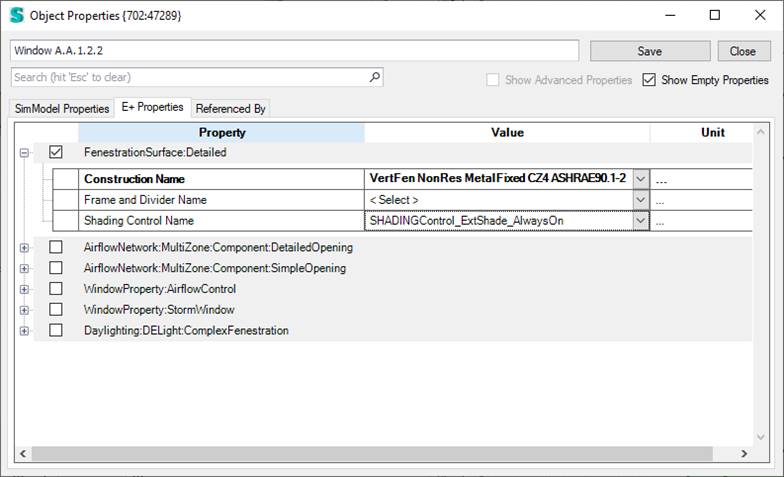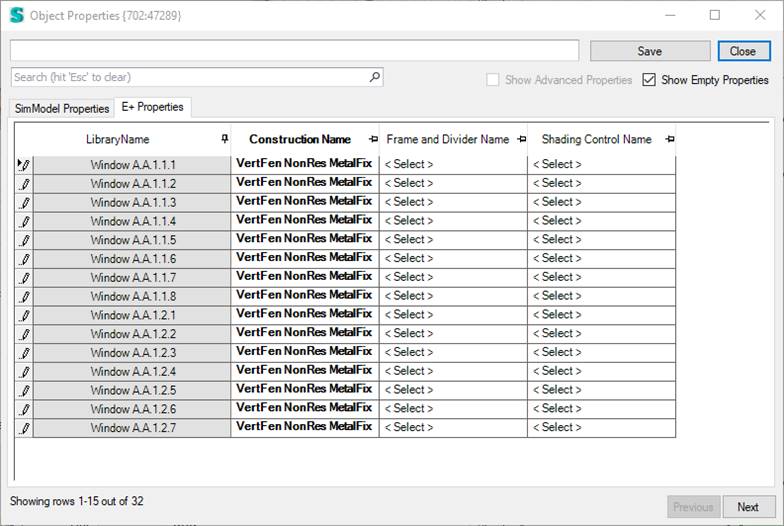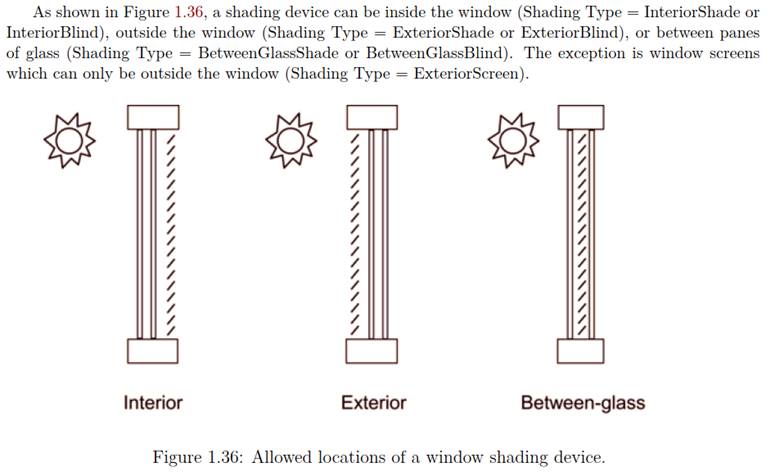How to model dynamic shades in Simergy?
Applying dynamic shading control to windows
1. Single windows
To get to the shading properties, select one or more windows and right click Properties.
In this property dialog there is one Property called “Shading Control Name” that hold the reference to a so-called shading controller in this case: “SHADINGControl_ExtShade_AlwaysOn”.

2. Multiselect
You can also multiselect windows and use the same property dialog from above to assign shading controls. Either by selecting the manually or by using the select options in the right click menu.
3. Edit windows in table
The third option is to use the Edit in Table right click menu option to get an overview of all the windows and their properties. Here it is also easy to apply a shading control to just the windows needed.

4. Window Type
You can also attach the shading controller to a window type that you can use in the Building Model CreatorTM so that the shading can be applied to all windows right from the moment you generate the building model or later when you edit it. You can find this option in the Glazing tab.

Shading location

Shading types
The following tables summarizes the available shading types. Specifies the location, the related material/construction, and other requirements. There are two ways depending on your shading type either you need to define just the shading material layer that gets added to the existing window construction or you need to define a new construction with the shading device included. In the later case, the construction on the window and the construction on the shade controller need to be different just in the shading layer. For in between shading, you can obviously just use it with a double or triple glazing construction.
|
Shading Type |
Location |
WindowMaterial |
Construction or material |
Requirements |
|
InteriorShade |
Interior |
Shade |
Material |
|
|
ExteriorShade |
Exterior |
Shade |
Material |
|
|
BetweenGlassShade |
Between glass layers |
Shade |
Construction |
Double glazing |
|
Between inner glass layers |
Triple glazing |
|||
|
ExteriorScreen |
Exterior |
Screen |
Material |
|
|
InteriorBlind |
Interior |
Blind |
Material |
|
|
ExteriorBlind |
Exterior |
Blind |
Material |
|
|
BetweenGlassBlind |
Between glass layers |
Blind |
Construction |
Double glazing |
|
Between inner glass layers |
Triple glazing |
|||
|
SwitchableGlazing |
|
|
Construction |
|
Shading control types
The following tables describes the details on different shading control types.
|
Shading Control Type |
Description |
Scheduled |
Requires Daylighting |
Exterior Window Screen |
|
AlwaysOn |
|
|
X |
|
|
|
Shading is always on |
|
|
|
|
AlwaysOff |
|
|
X |
|
|
|
Shading is always off. |
|
|
|
|
OnIfScheduleAllows |
X |
|
X |
|
|
|
Shading is on if schedule value is non-zero. Requires that Schedule Name be specified and Shading Control Is Scheduled = Yes. |
|
|
|
|
OnIfHighSolarOnWindow |
X |
|
|
|
|
|
Shading is on if beam plus diffuse solar radiation incident on the window exceeds Solar Setpoint (W/m2) |
|
|
|
|
OnIfHighHorizontalSolar |
X |
|
|
|
|
|
Shading is on if total (beam plus diffuse) horizontal solar irradiance exceeds Solar Setpoint (W/m2). |
|
|
|
|
OnIfHighOutdoorAirTemperature |
X |
|
|
|
|
|
Shading is on if outside air temperature exceeds Temperature SetPoint (C). |
|
|
|
|
OnIfHighZoneAirTemperature |
X |
|
|
|
|
|
Shading is on if zone air temperature in the previous timestep exceeds Temperature SetPoint (C). |
|
|
|
|
OnIfHighZoneCooling |
X |
|
|
|
|
|
Shading is on if zone cooling rate in the previous timestep exceeds Cooling or Heating SetPoint (W). |
|
|
|
|
OnIfHighGlare |
|
X |
|
|
|
|
Shading is on if the total daylight glare index at the zone’s first daylighting reference point from all of the exterior windows in the zone exceeds the maximum glare index specified in the day- lighting input for zone. |
|
|
|
|
MeetDaylightIlluminanceSetpoint |
|
X |
|
|
|
|
Used only with ShadingType = SwitchableGlazing in zones with daylighting controls. In this case the transmittance of the glazing is adjusted to just meet the daylight illuminance set point at the first daylighting reference point. Note that the daylight illuminance set point is specified in the Daylighting:Controls object for the Zone; it is not specified as a WindowShadingControl SetPoint. When the glare control is active, if meeting the daylight illuminance set point at the first day- lighting reference point results in higher discomfort glare index (DGI) than the specified zone’s maximum allowable DGI for either of the daylight reference points, the glazing will be further dimmed until the DGI equals the specified maximum allowable value. |
|
|
|
|
OnNightIfLowOutdoorTempAndOffDay |
X |
|
|
|
|
|
Shading is on at night if the outside air temperature is less than exceeds Temperature SetPoint (C). Shading is off during the day. |
|
|
|
|
OnNightIfLowInsideTempAndOffDay |
X |
|
|
|
|
|
Shading is on at night if the zone air temperature in the previous timestep is less than Temperature SetPoint (C). Shading is off during the day. |
|
|
|
|
OnNightIfHeatingAndOffDay |
X |
|
|
|
|
|
Shading is on at night if the zone heating rate in the previous timestep exceeds Cooling or Heating SetPoint (W). Shading is off during the day. |
|
|
|
|
OnNightIfLowOutdoorTempAndOnDayIfCooling |
X |
|
|
|
|
|
Shading is on at night if the outside air temperature is less than Temperature SetPoint (C). Shading is on during the day if the zone cooling rate in the previous timestep is non-zero. |
|
|
|
|
OnNightIfHeatingAndOnDayIfCooling |
X |
|
|
|
|
|
Shading is on at night if the zone heating rate in the previous timestep exceeds Cooling or Heating SetPoint (W). Shading is on during the day if the zone cooling rate in the previous timestep is non-zero. |
|
|
|
|
OffNightAndOnDayIfCoolingAndHighSolarOnWindow |
X |
|
|
|
|
|
Shading is off at night. Shading is on during the day if the solar radiation incident on the window exceeds Solar SetPoint (W/m2) and if the zone cooling rate in the previous timestep is non-zero. |
|
|
|
|
OnNightAndOnDayIfCoolingAndHighSolarOnWindow |
X |
|
|
|
|
|
Shading is on at night. Shading is on during the day if the solar radiation incident on the window exceeds Solar SetPoint (W/m2) and if the zone cooling rate in the previous timestep is non-zero. |
|
|
|
|
OnIfHighOutdoorAirTempAndHighSolarOnWindow |
|
|
|
|
|
|
Shading is on if the outside air temperature exceeds the Temperature SetPoint (C) and if the solar radiation incident on the window exceeds Solar SetPoint (W/m2). |
|
|
|
|
OnIfHighOutdoorAirTempAndHighHorizontalSolar |
|
|
|
|
|
|
Shading is on if the outside air temperature exceeds the Temperature SetPoint (C) and if the horizontal solar radiation exceeds Solar SetPoint (W/m2). |
|
|
|
